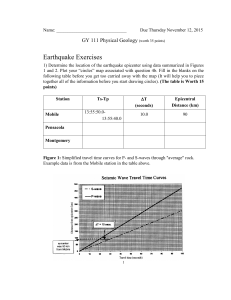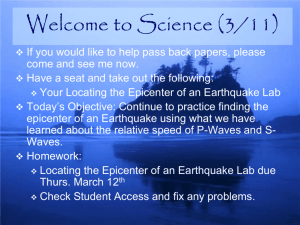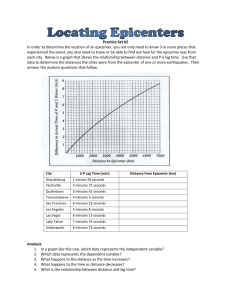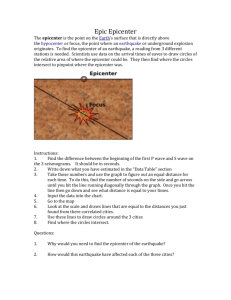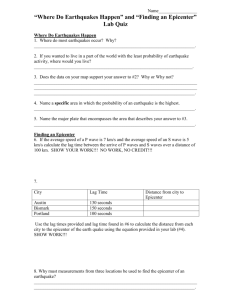Document 11665467
advertisement
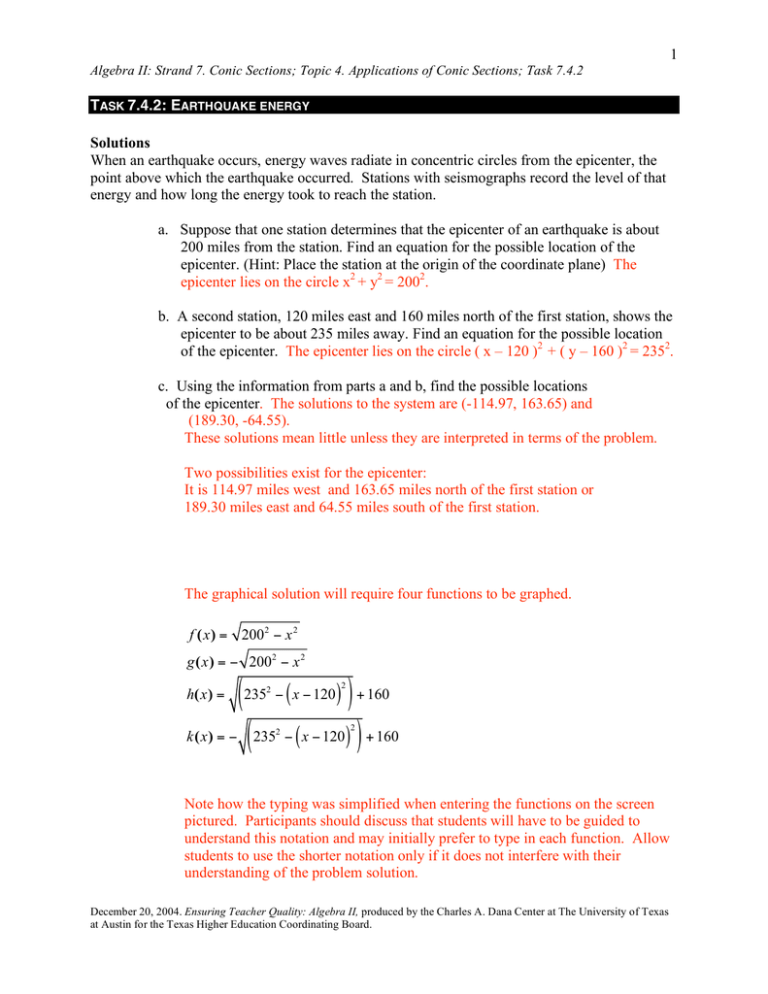
1 Algebra II: Strand 7. Conic Sections; Topic 4. Applications of Conic Sections; Task 7.4.2 TASK 7.4.2: EARTHQUAKE ENERGY Solutions When an earthquake occurs, energy waves radiate in concentric circles from the epicenter, the point above which the earthquake occurred. Stations with seismographs record the level of that energy and how long the energy took to reach the station. a. Suppose that one station determines that the epicenter of an earthquake is about 200 miles from the station. Find an equation for the possible location of the epicenter. (Hint: Place the station at the origin of the coordinate plane) The epicenter lies on the circle x2 + y2 = 2002. b. A second station, 120 miles east and 160 miles north of the first station, shows the epicenter to be about 235 miles away. Find an equation for the possible location of the epicenter. The epicenter lies on the circle ( x – 120 )2 + ( y – 160 )2 = 2352. c. Using the information from parts a and b, find the possible locations of the epicenter. The solutions to the system are (-114.97, 163.65) and (189.30, -64.55). These solutions mean little unless they are interpreted in terms of the problem. Two possibilities exist for the epicenter: It is 114.97 miles west and 163.65 miles north of the first station or 189.30 miles east and 64.55 miles south of the first station. The graphical solution will require four functions to be graphed. f (x) = 2002 ! x 2 g(x) = ! 2002 ! x 2 (235 ! ( x ! 120) ) + 160 k(x) = ! ( 235 ! ( x ! 120 ) ) + 160 h(x) = 2 2 2 2 Note how the typing was simplified when entering the functions on the screen pictured. Participants should discuss that students will have to be guided to understand this notation and may initially prefer to type in each function. Allow students to use the shorter notation only if it does not interfere with their understanding of the problem solution. December 20, 2004. Ensuring Teacher Quality: Algebra II, produced by the Charles A. Dana Center at The University of Texas at Austin for the Texas Higher Education Coordinating Board. 2 Algebra II: Strand 7. Conic Sections; Topic 4. Applications of Conic Sections; Task 7.4.2 graph #1 graph #2 Finding the intersections can be challenging. To find the intersection in graph #1, use Y1 and Y5. To find the intersection in graph #2, use Y2 and Y4. An algebraic solution to the system will be tedious and may convince those persons who are resistant to the use of technology to embrace it. Teaching notes Allow participants to work in pairs to solve the problem. Give them plenty of time to read and start the problem before any class discussion takes place. Distribute blank transparencies to several pairs asking them to write up their solutions to present to the group. This problem contains sufficient scaffolding that the solution equations will probably be identical. The only differences may be in the solution strategy: graphical or algebraic. December 20, 2004. Ensuring Teacher Quality: Algebra II, produced by the Charles A. Dana Center at The University of Texas at Austin for the Texas Higher Education Coordinating Board. 3 Algebra II: Strand 7. Conic Sections; Topic 4. Applications of Conic Sections; Task 7.4.2 TASK 7.4.2: EARTHQUAKE ENERGY When an earthquake occurs, energy waves radiate in concentric circles from the epicenter, the point above which the earthquake occurred. Stations with seismographs record the level of that energy and how long the energy took to reach the station. a. Suppose that one station determines that the epicenter of an earthquake is about 200 miles from the station. Find an equation for the possible location of the epicenter. (Hint: Place the station at the origin of the coordinate plane) b. A second station, 120 miles east and 160 miles north of the first station, shows the epicenter to be about 235 miles away. Find an equation for the possible location of the epicenter. c. Using the information from parts a and b, find the possible locations of the epicenter. December 20, 2004. Ensuring Teacher Quality: Algebra II, produced by the Charles A. Dana Center at The University of Texas at Austin for the Texas Higher Education Coordinating Board.

